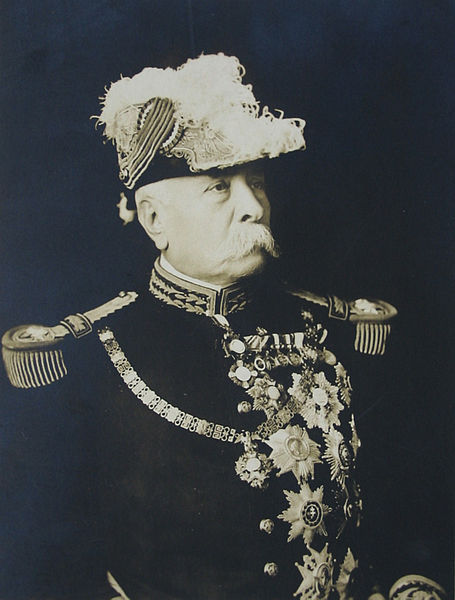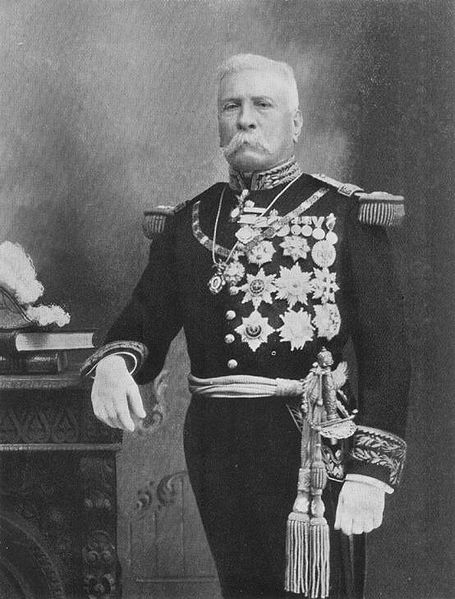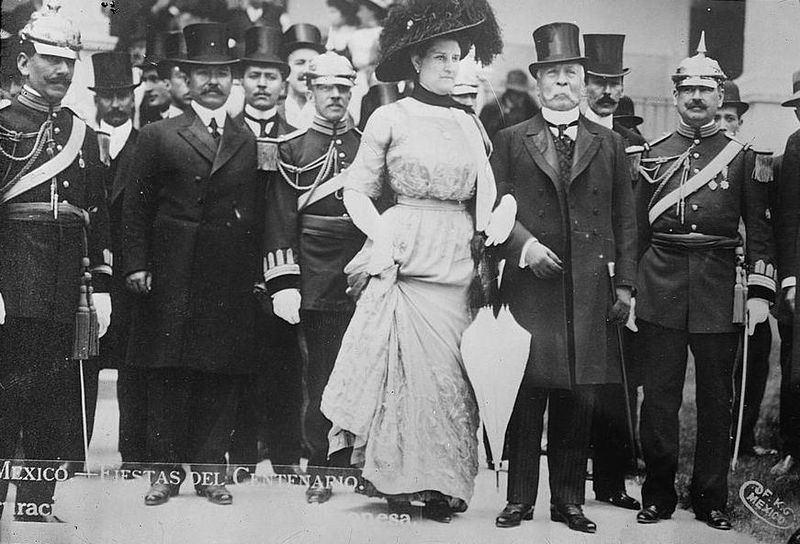<Back to Index>
- 29th President of Mexico José de la Cruz Porfirio Díaz Mori, 1830
PAGE SPONSOR



José de la Cruz Porfirio Díaz Mori (15 September 1830 - 2 July 1915) was a volunteer in the Reform War and then a leader of the successful rebellion against French intervention, an accomplished general and the President of Mexico from 1876 to 1911, with the exception of a brief term in 1876 when he left Juan N. Méndez as interim president, and a four year term served by his political ally Manuel González from 1880 to 1884. Commonly considered by historians to have been a dictator, he is a controversial figure in Mexican history. The period of his leadership was marked by significant internal stability (known as the "paz porfiriana"), modernization, and economic growth. However, Díaz's regime grew unpopular due to repression and political stagnation, and he fell from power during the Mexican Revolution, after he had imprisoned his electoral rival and declared himself the winner of an eighth term in office. The 35 years in which Díaz ruled Mexico are referred to as the Porfiriato.
Porfirio Díaz was born on 15 September 1830, in Oaxaca, Mexico, to a Native Mexican mother and a Criollo father. His father, José de la Cruz was a modest innkeeper and died when his son was just an infant.
Díaz began training for the priesthood at the age of fifteen when his mother, María Petrona Mori Cortés, sent him to the Seminario Conciliar. In 1850, inspired by Liberal Benito Juárez, Díaz entered the Instituto de Ciencias and spent some time studying law. Having dabbled in many different professions, Díaz discovered what would be his life's calling when he decided to join the armed forces upon the outbreak of war with the United States in 1846. In 1855, Diaz joined a band of liberal guerrillas who were fighting a resurgent Antonio López de Santa Anna.
Díaz’s military career is most noted for his service in the Reform War and the struggle against the French. By the time of the Battle of Puebla (5 May 1862), General Díaz had become the brigadier general in charge of an infantry brigade.
During the Battle of Puebla, his brigade was placed in the center between the forts of Loreto and Guadalupe. From there, he repelled a French infantry attack that was sent as a diversion to distract the Mexican commanders' attention from the forts that were the main target of the French army. In violation of the orders of General Ignacio Zaragoza, General Díaz and his unit fought off a larger French force and then chased after them. Despite Díaz’s inability to share control, General Zaragoza commended the actions of General Díaz during the battle as "brave and notable".
In 1863, Díaz was captured by the French Army. He escaped and was offered by President Benito Juárez the positions of secretary of defense or army commander in chief. He declined both but took an appointment as commander of the Central Army. That same year he was promoted to the position of Division General.
In 1864, the conservatives supporting Emperor Maximilian asked him to join the Imperial cause. Díaz declined the offer. In 1865, he was captured by the Imperial forces in Oaxaca. He escaped and fought the battles of Tehuitzingo, Piaxtla, Tulcingo and Comitlipa.
In 1866, Díaz formally declared loyalty. That same year he earned victories in Nochixtlan, Miahuatlan, and La Carbonera, and once again captured Oaxaca. He was then promoted to general. Also in 1866, Marshal Bazaine, commander of the Imperial forces, offered to surrender Mexico City to Díaz if he withdrew support of Juárez. Díaz declined the offer. In 1867, Emperor Maximilian offered Díaz the command of the army and the imperial rendition to the liberal cause. Díaz refused both. Finally, on 2 April 1867, he went on to win the final battle for Puebla.
When Juárez became the president of Mexico in 1868 and began to restore peace, Díaz resigned his military command and went home to Oaxaca. However, it did not take long before the energetic Díaz became unhappy with the Juárez administration.
In 1871, Díaz led a revolt against the re-election of Juárez. In March 1872 Díaz’s forces were defeated in the battle of La Bufa in Zacatecas. Following Juárez's death on 9 July of that year, Sebastián Lerdo de Tejada assumed the presidency and offered amnesty to the rebels. Díaz accepted in October and "retired" to the Hacienda de la Candelaria in Tlacotalpan, Veracruz. However, he remained very popular among the people of Mexico.
In 1874 he was elected to Congress from Veracruz. That year Lerdo de Tejada's government faced civil and military unrest, and offered Díaz the position of ambassador to Germany, which he refused. In 1875 Díaz traveled to New Orleans and Brownsville, Texas, to plan a rebellion, which was launched in Ojitlan, Oaxaca, on 10 January 1876 as the "Plan de Tuxtepec".
Díaz continued to be an outspoken citizen and led a second revolt against Lerdo de Tejada in 1876. This attempt also failed and Díaz fled to the United States of America. His fight, however, was far from over.
Several months later, in November 1876, Díaz returned to Mexico and fought the Battle of Tecoac, where he defeated the government forces once and for all (on 16 November). Finally, on 12 May 1877, Díaz was elected president of Mexico for the first time. His campaign of "no re-election", however, came to define his control over the state for more than thirty years.
In 1870, Díaz ran as a presidential candidate against President Juárez and Vice President Sebastián Lerdo de Tejada. In 1871 he made claims of fraud in the July elections won by Juárez, who was confirmed as president by the Congress in October. In response, Díaz launched the Plan de la Noria on 8 November, supported by a number of rebellions across the nation.
After appointing himself president on 28 November 1876, he served only one term — having staunchly stood against Lerdo's re-election policy. During his first term in office, Díaz's son Raffah created a political machine that held immense power over the people of Mexico. He maintained control through manipulation of votes, but also through simple violence and assassination of his opponents, who consequently were few in number. His administration became famous for their suppression of civil society and public revolts. Instead of running for a second term, he handpicked his successor, Manuel González, one of his trustworthy companions. This surreptitious side step maneuver, however, did not mean that Díaz was stepping down from his powerful throne.
The four year period that followed was marked by corruption and official incompetence, so that when Díaz stepped up in the election of 1884, he was welcomed by his people with open arms. More importantly, very few people remembered his "No re-election" slogan that defined his previous campaign. During this period the Mexican underground political newspapers spread the new ironic slogan for the Porfirian times, based on the slogan "Sufragio Efectivo, No Reelección" and changed it to "Sufragio Efectivo No, Reelección”. In any case Díaz had the constitution amended, first to allow two terms in office, and then to remove all restrictions on re-election.
Having created a band of military brothers, Díaz went on to construct a broad coalition. He was a cunning politician and knew very well how to manipulate people to his advantage. A phrase used to describe the order of his rule was "Pan, o palo", "Bread or a beating," (literally "Bread, or stick"), meaning that one could either accept what was given willingly (often a position of political power) or else face harsh consequences (often death). Either way, rising opposition to Díaz’s administration was immediately quelled.
Over the next twenty - six years as president, Díaz created a systematic and methodical regime with a staunch military mindset. His first goal was to establish peace throughout Mexico. According to the late UCLA Spanish professor John A. Crow, Díaz "set out to establish a good strong paz porfiriana, or Porfirian peace, of such scope and firmness that it would redeem the country in the eyes of the world for its sixty - five years of revolution and anarchy." His second goal was outlined in his motto – "little of politics and plenty of administration."
In reality he started a Mexican revolution; however, his fight for profits, control, and progress kept his people in a constant state of uncertainty. Díaz managed to dissolve all local authorities and all aspects of federalism that once existed. Not long after he became president, the leaders of Mexico were answering directly to him. Those who held high positions of power, such as members of the legislature, were almost entirely his closest and most loyal friends. In his quest for even more political control, Díaz suppressed the media and controlled the court system.
In order to secure his power, Díaz engaged in various forms of co-optation and coercion. He played his people like a board game – catering to the private desires of different interest groups and playing off one interest against another. In order to satisfy any competing forces, such as the Mestizos and wealthier indigenous people, he gave them political positions of power that they could not refuse. He did the same thing with the elite Creole society by not interfering with their wealth and haciendas. When it came to the Roman Catholic Church, Díaz proved to be a different kind of Liberal than those of the past. He neither assaulted the Church (like most liberals) nor protected the Church. As for the Native American population, who were historically repressed, they were almost completely depoliticized; neither put on a pedestal as the core of Mexican society nor suppressed, and were largely left to advance via their own means. In giving different groups with potential power a taste of what they wanted, Díaz created the illusion of democracy and quelled almost all competing forces.
Díaz knew that it was crucial for him to suppress banditry; he expanded the guardias rurales (countryside police), although it guarded chiefly only transport routes to major cities. Díaz thus worked to enhance his control over the military and the police.
From 1892 onward, Díaz's perennial opponent was the eccentric Nicolás Zúñiga y Miranda, who lost every election but always claimed fraud and considered himself to be the legitimately elected president of Mexico.
Crow states, "It was the golden age of Mexican economics, 3.2 dollars per peso. Mexico was compared economically to economic powers of the time such as France, Great Britain, and Germany. For some Mexicans, there was no money and the doors were thrown open to those who had." Also, economic progress varied drastically from region to region. The north was defined by mining and ranching while the central valley became the home of large scale farms for wheat and grain and large industrial centers.
One component of economic growth involved stimulating foreign investment in the Mexican mining sector. Through tax waivers and other incentives, investment and growth were effectively realized. The desolate region of Baja California Sur benefited from the establishment of an economic zone with the founding of the town of Santa Rosalia and the commercial development of the El Boleo copper mine. This came about when Diaz granted a French mining company a 70 year tax waiver in return for its substantial investment in the project. In a similar fashion, the city of Guanajuato realized substantial foreign investment in local silver mining ventures. The city subsequently experienced a period of prosperity, symbolized by the construction of numerous landmark buildings, most notably, the magnificent Juarez Theater.
Because Díaz had created such an effective centralized government, he was able to concentrate decision making and maintain control over the economic instability. This instability arose largely as a result of the dispossession of hundreds of thousands of peasants of their land. Communal indigenous landholdings were privatized, subdivided and sold. The Porfiriato thus generated a stark contrast between rapid economic growth and sudden, severe impoverishment of the rural masses, a situation that was to explode in the Mexican revolution of 1910.
On 17 February 1908, in an interview with the U.S. journalist James Creelman of Pearson's Magazine, Díaz stated that Mexico was ready for democracy and elections and that he would retire and allow other candidates to compete for the presidency. Without hesitation, several opposition and pro-government groups united to find suitable candidates who would represent them in the upcoming presidential elections. Many liberals formed clubs supporting the governor of Nuevo León, Bernardo Reyes, as a candidate for the presidency. Despite the fact that Reyes never formally announced his candidacy, Díaz continued to perceive him as a threat and sent him on a mission to Europe, so that he was not in the country for the elections.
According to Crow, "A cautious but new breath entered the prostrate Mexican underground. Dark undercurrents rose to the top." As groups began to settle on their presidential candidate, Díaz decided that he was not going to retire but rather allow Francisco Madero, an aristocratic but democratically leaning reformer, to run against him. Although Madero, a landowner, was very similar to Díaz in his ideology, he hoped for other elites in Mexico to rule alongside the president. Ultimately, however, Díaz did not approve of Madero and had him jailed during the election in 1910. Despite what he had formerly said about democracy and change, sameness seemed to be the only reality.
Despite this, the election went ahead. Madero had gathered much popular support, but when the government announced the official results, Díaz was proclaimed to have been re-elected almost unanimously, with Madero gathering only a minuscule number of votes. This case of massive electoral fraud aroused widespread anger throughout the Mexican citizenry. Madero called for revolt against Díaz, and the Mexican Revolution began. Díaz was forced from office and fled the country for Spain on May 31, 1911.
On 2 July 1915, after two marriages and three children, Díaz died in exile in Paris. He is buried there in the Cimetière du Montparnasse.
In 1938, the 430 piece collection of arms of the late General Porfirio Díaz was donated to the Royal Military College of Canada in Kingston, Ontario.
The main Mexican holiday is the Day of Independence, celebrated on September 16. Americans are more familiar with the Cinco de Mayo. Cinco de Mayo commemorates the date of the Battle of Puebla, in which Díaz participated, when a major victory was won against the French. Under the Porfiriato, the Mexican Consuls in the United States gave Cinco de Mayo more importance than the Day of Independence due to the President's personal involvement in the events. It is still widely celebrated in the United States, although largely due to cultural permeation.
- Díaz is usually credited with the saying, "¡Pobre México! ¡Tan lejos de Dios y tan cerca de los Estados Unidos!" (Poor Mexico, so far from God and so close to the United States!), although there is little evidence that Diaz made this remark. Even Díaz biographer Paul Garner has noted that when the saying is attributed to Diaz, no source is typically given.
- Referring to his policy of co-opting political opponents, Díaz reportedly said, "a dog with a bone neither barks nor bites" or "a dog with a bone in its mouth neither steals nor kills."
- As he headed for exile in May 1911 following the revolt by Francisco Madero, Díaz reportedly remarked, "Madero has unleashed a tiger; let’s see if he can tame it." Madero was assassinated in 1913, beginning years of upheaval and civil war, and after his death stability would not be restored before the administration of Venustiano Carranza in 1920.
- Díaz's most infamous quote was the order to Veracruz's governor, Luis Raul Mier y Terán, about a group of followers of Sebastián Lerdo de Tejada: "¡Mátalos en caliente!" (Kill them on the spot!).

